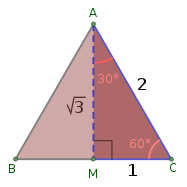Top Qs
Timeline
Chat
Perspective
Square root of 3
Unique positive real number which when multiplied by itself gives 3 From Wikipedia, the free encyclopedia
Remove ads
The square root of 3 is the positive real number that, when multiplied by itself, gives the number 3. It is denoted mathematically as or . It is more precisely called the principal square root of 3 to distinguish it from the negative number with the same property. The square root of 3 is an irrational number. It is also known as Theodorus's constant, after Theodorus of Cyrene, who proved its irrationality.[1]
In 2013, its numerical value in decimal notation was computed to ten billion digits.[2] Its decimal expansion, written here to 60 decimal places, is given by OEIS: A002194:
- 1.732050807568877293527446341505872366942805253810380628055806
Archimedes reported a range for its value: .[3]
The upper limit is an accurate approximation for to (six decimal places, relative error ) and the lower limit to (four decimal places, relative error ).
Remove ads
Geometry and trigonometry
Summarize
Perspective
The height of an equilateral triangle with edge length 2 is √3. Also, the long leg of a 30-60-90 triangle with hypotenuse 2.
And, the height of a regular hexagon with sides of length 1

The square root of 3 can be found as the leg length of an equilateral triangle that encompasses a circle with a diameter of 1.
If an equilateral triangle with sides of length 1 is cut into two equal halves, by bisecting an internal angle across to make a right angle with one side, the right angle triangle's hypotenuse is length one, and the sides are of length and . From this, , , and .
The square root of 3 also appears in algebraic expressions for various other trigonometric constants, including[4] the sines of other angles.
It is the distance between parallel sides of a regular hexagon with sides of length 1.
It is the length of the space diagonal of a unit cube.
The vesica piscis has a major axis to minor axis ratio equal to . This can be shown by constructing two equilateral triangles within it.
Remove ads
References
Further reading
External links
Wikiwand - on
Seamless Wikipedia browsing. On steroids.
Remove ads




















